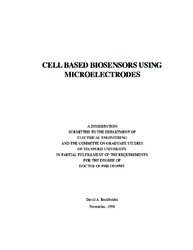| dc.description.abstract | Instruments for the study of living cells have historically been of significant
importance for such things as basic neuroscience and cell biology. More recent work has included extending the use of cell based sensors to pharmaceutical screening,
environmental monitoring, and toxin detection. While there are a variety of different measurement techniques, microelectrode arrays provide a simple interface for monitoring the electrical activity and impedance characteristics of populations of cultured cells over extended periods. The cell/sensor interface is created as cells attach directly to planar electrode structures. With excitable cells, both intrinsic and stimulated electrical activity
has been directly monitored in this way. Impedance techniques have also been used to
monitor such things as cellular adhesion, motility and proliferation of both electrically active and non-electrically active cell types. For this work, a 36 element array of platinized platinum electrodes was packaged and used as a substrate for the culture of neurons, cardiac and glial cells. Electrical activity
from a spontaneously beating syncytium of cardiac cells was monitored and analyzed in
detail. Power spectral density analysis was used as a means of identifying the class of
ionic channel affected by pharmacological compounds or toxins. Impedance measurements on neurons and glial cells were targeted towards measuring changes in cellular membrane conductance in addition to cellular adhesion and motility.
This thesis describes the basic cell theory relevant to measurement of electrical activity and cellular impedance. Classical measurement techniques are compared to planar
microelectrode array technologies. New packaging technologies and systems developed
for both electrical activity and impedance measurements are described along with
pharmacological data for neurons, cardiac and glial cells. The practicality of using
microelectrode based sensor technologies for monitoring the activity of cultured cells is
discussed. | en_US |

